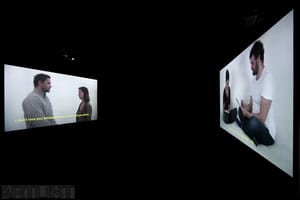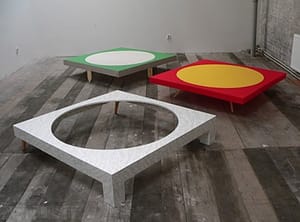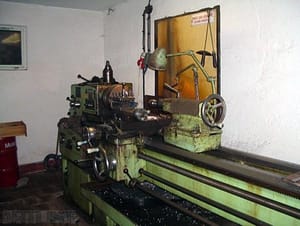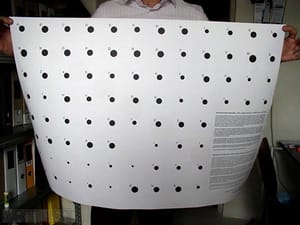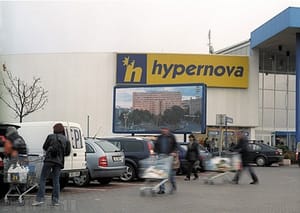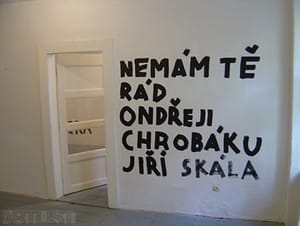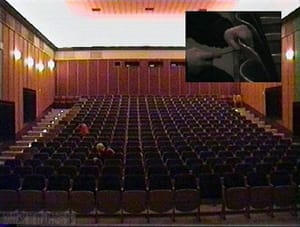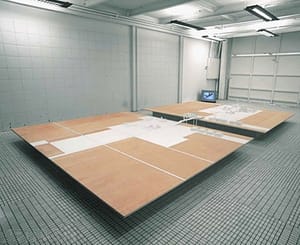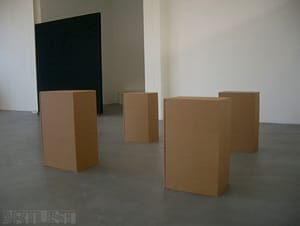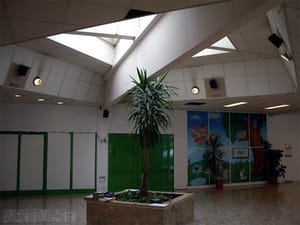- Jméno
- Jiří
- Příjmení
- Skála
- Narozen/a
- 1976
- Místo narození
- Sušice
- Působiště
- Prague
- i-datum
- ↳ Vyhledat v databázi VVP AVU
- Klíčová slova
- Knihovna CSU
- ↳ Vyhledat v katalogu
O umělci
According to established theoretical convention the work of the artist Jiří Skála can be dubbed conceptual, though it does not fit comfortably into this category. This is despite the fact that Skála’s thinking is linked to conceptualism by its strictly polarised oppositions between text and object, picture and gallery space. To begin with he flirted with the suspended painterly form. This period saw a series of painted Flags, as well as the video performance Harmony Corruption. An already primed canvas was gradually turned into a total of four frames. Another example that again draws on painterly determined resources is Local Stigma. The video recording retained the simple preparation and priming of the canvas prior to the act of painting. The principle was to record several different methods of work, the joint objective of which is a painting on canvas. Skála was the creator of a plan with which everything complied.
Skála’s work gradually moved toward the thematising of textual narrative and the search for an alternative mode of communication that could allow for the relevant existence of narrative, either in a gallery or public space. In 2006 he created one of the important examples of this style entitled Exchange of Handwriting. He undertook the first version in Art in General in New York and at the end of the same year presented the second version of the project at the Atrium of Pražák Palace, Brno. He used the method of acquiring a manuscript in the opposite sense of verbal communication, by means of which we usually get to know the other. This fact of getting to know the other is supported by the presence of a female and male subject. In its way this was a contemplative workshop updating the concept of authorship. In 2007 at the Gallery Hunt Kastner an exhibition was held entitled “Two Groups of Subjects” that paraphrased an essay by the Italian writer Umberto Eco, in which Skála began to investigate the duality of socially and privately determined relations to consumer production by means of work or leisure resources. In 2010 he published a book entitled “One Group of Subjects”, in which the role of the text and object bring together that socially determining potential that Skála continues to systematically develop. The basis of the book is formally constructed on a descriptive form of narration, a strategy of experimental poetry evoking a list of engineering objects, and on the amateur photo-documentation of these objects by their users, i.e. the generation of artistic parents (now in the fifties and sixties), for whom these tools were a means of support in very clearly demarcated working hours, after which followed leisure time, usually filled by another kind of activity.
Skála subsequently used the relationship between narrative and the technological object when creating his internet blog. This served him as a virtual surface on which to hang videos of “unboxing”. New owners of technological devices (mainly smartphones, computers and digital cameras) film themselves while opening bulky cardboard boxes and upload the result to the web. This is accompanied by texts that are almost journal-like in character in which these technophiles describe their experience with the devices and again publish it somewhere on internet islands. Skála selected what he felt to be the most interesting examples of this huge volume of visual and textual material and then either manipulated the texts or write his own version. One could argue that he was interested in capturing the current generational level of consumers, where the originally clear boundary between leisure and work is gradually being eroded. The social dimension to Skála’s activities consists in the attempt to reveal the mechanisms that radically expose our privacy and enter into the sphere of the totally public. Text is then a tool for the poeticisation of the artificial and motionless reality of the object, be this a symbol of desire or utilitarian production resource.
After one year of its operations the blog gave rise to a series of performative readings in the Gallery Hunt Kastner Artworks, Prague. On this occasion Skála had the opportunity to utilise the conception of his blog physically, and to be inspired by the concept of the Prague Free Theatre and the stage concepts of Jindřich Honzl, Jiří Frejka and E. F. Burian. The original material of the unboxing videos was alternated in the gallery with readings of individual passages from the blog. Non-actors were invited to read the texts and were required by Skála, acting in the role of director, to restrict themselves exclusively to intelligible and fluent reading (with the occasional change of place within the gallery).
Author
Radim Langer
- Autor/ka anotace
- Radim Langer
- Publikováno
- 2013
Profesní životopis
Studies:
1998-2004 Academy of Fine Arts, Prague (studios of Jiri David and Vladimír Skrepl)
Awards:
2009 Jindřich Chalupecký Prize
Stipends:
2003 Palais de Tokyo, post-graduate program, Paris, France
2004 Quartier 21, artist residency program, Muzeum Quartier, Vienna
2005 Art in General, artist residency program, N.Y., New York
2006 Residency in Bucharest, Rumania, as a part of the project How to Do Things? – In the Middle of (No)where… organized by uqbar-Gesellschaft für Repräsentationsforschung, Berlin
- Členství ve skupinách zařazených do databáze
Výstavy
- Samostatné výstavy
-
2012
Third Family of Objects and Confrontational Readings, hunt kastn er, Prague
2010
Messages in an Emergency, Czech Center New York, N.Y., USA
You are the Object, I am the Pronoun, Václav Spála Gallery, Prague
2007
Two Families of Objects, hunt kastner, Prague
2006
Výměna rukopisu / Exchange of Handwriting, Moravian Gallery, Pražákův palác Atrium, Brno
Exchange of Handwriting, Art in General, New York, N.Y., USA
2005
The Pacific Has no Memory, Galerie Eskort, Brno
2004
Local Stigma, FUTURA, Prague
DOS, Labour Union House, public art project on a billboard, Prague
2002
Hygiena, Galerie Display, Prague
2001
Microfiltration, (with Marek Ther), Galerie Jelení, Foundation and Center for Contemporary Arts, Prague
- Skupinové výstavy nezařazené do databáze
-
2013
The Earth Turns and All Things Slip Away, curated by Edith Jeřabková and Jiří Kovanda, hunt kastner, Prague
2012
Ça & là (This & There), curated by Claude Closky, Fondation d´entreprise Ricard, Paris
Family Talk, curated by Marco Antonini, Futura, Prague
Beginning of the Century, curated by Pavlina Morganová, Pilsen Regional Gallery, Pilsen
Between the First and Second Modernity, 1985-2012, curated by Jiří Ševčík, Edith Jeřábková and Jana Ševčíková,
National Gallery in Prague at the Veletřžní Palace, Prague
A Plea for Tenderness, curated by David Raymond Conroy, Seventeen Gallery, London, UK
The Eleventh Hour, curated by Michal Novotny, FUTURA, Prague
2011
Young Visual Artist Awards, curated by Rita Kalman, Tijana Stepanovic and Lucia Gavulová, Slovak National Galerie,
Bratislava, SK
Mistrust of the Inteligencia, curated by Pavel Sterec and Tereza Stejskalová, Open Gallery at the Foundation and Center
for Contemporary Arts, Bratislava, SK
12 POINT: Petr Babák, Petr Bosák, Robert Jansa, Jiří Kovanda, Jan Nalevka, Radim Pesko, Jiří Skála, Jan Šerých, curated
by Adela Svobodova, 35m2, Prague
Les amis des mes amis sont mes amis, Hommage a Ján Mančuška, Galerie Jocelyn Wolff, Paris, FR
VI NEW ZLIN SALON, Zlin Regional Art Gallery, Zlin
Sculpture in the Street II, curated by Karel Cisar, organized by DUMB: Brno House of Arts, streets and public spaces in
Brno
The Other Tradition, curated by Elena Filipovic, Wiels Contemporary Art Centre, Brussels, BE
2010
U bUdU tU bUdU, curated by Viktor +cech, Skolska 28, Prague, CZ
Jindřich Chalupecký Award Winners – 20 Years, Dox Center for Contemporary Art, Prague
Image at Work, curated by Helena Holmberg, a project initiated by Xposeptember, Romanian Culture Institute,
Stockholm, Sweden
There has been no Future, There will be no Past, ISCP, New York, N.Y., USA
A Map Bigger than its Surface, Rotor Gallery, University of Gothenburg, Gothenburg, Sweden
Space Demonstration, curated by Ladví, Street for Art Festival, BLOX Docasne centrum umeni by TOUAX, Prague
After Velvet, curated by Sandra Baborovská, Prague City Gallery, House of the Golden Ring, Prague
Gaspard of the Night, curated by Vaclav Magid, FUTURA, Prague
Oral Fixations, Jiří Skála and Radím Labuda, gumSTUDIO, Carrara, Italy
2009
Chalupecký Award finalists exhibition, DOX Center for Contemporary Art, Prague
The Situation, 3rd Moscow Biennale of Contemporary Art, curated by Elizabeth Grady, Solyanka Gallery, Moscow,
Russia
SKUTR II, Biennale of Young Artists, Kopplovas Vila, Trnava, Slovakia
Psychologie budoucností, A.M.180, Prague
2008
2008 Jindřich Chalupecký Award Finalists Exhibition, House of the Lords of Kunštát, House of Arts, Brno
X+X 2008: 10 plus 10 artists from the Pilsen and Oberfalz region, curated by Jurgen Huber and Edith
Jerabková, Galerie Klatovy / Klenová, Klatovy
ARS TELEFONICA, site-specific interventions in phone booths, Centre for Visual Introspection, Bucharest, RO
6th Biennale of Young Artists, curated by Karel Císář, Prague City Gallery, House of the Stone Bell, Prague
Die Gehilfe, Galerie Klatovy / Klenová, Klatovy
Monument to Transformation, Fragment # 6: Labour Day, (with Gintaras Makarevicius & Ciprian Muresan),
LABOR,Budapest, Hungary2007
25 Years Later: Welcome to Art in General, UBS Art Gallery, New York, N.Y. , USA
FORM FOLLOWS... RISK, curated by Jana and Jiri Švečík, Karlín Studios and FUTURA in Prague & Slovak
National Gallery, Bratislava, Slovakia
Gross Domestic Product, curated by Kryštof Kintera, Prague City Gallery, Municipal Library, Prague
Festival of Regions 2007, Exits and Dead-ends, region of Kirchdorf-Krems, Austria
Autovision, (with Ondrej Brody, Viktor Freso & Evzen Simera), Old Town Hall, Prague City Gallery
2006
tranzit: Auditorium, Stage, Backstage - An Exposure in 32 Acts, curated by Vít Havránek, Frankfurter Kunstverein,
Frankfurt, Germany
ACNE, Contemporary Czech Painting from the Richard Adam Collection, Rudolfinum Gallery, Prague
I Invited Some Friends to Come and Watch, curated by David Kulhánek, Galerija M. Kraljevic + Galerija Nova, Zagreb,
Croatia
I, an exhibition in 3 acts, curated by Vit Havranek-Tranzit CZ, FUTURA, Prague and Galerie Grafisches Kabinett, Vienna,
Austria
Slepí muži přeměřují slona / Blind Men Measuring an Elephant, curated by Rafani, Gallery C2C, Prague
How to Do Things? – In the Middle of (No)where…, International Center for Contemporary Art, Bucharest, Romania,
and Kunstraum Kreuzberg/Bethanien, Berlin, Germany
Office Art, curated by Zuzana Štefková, Gallery C2C, Prague
2005
1811197604122005, organized by Galerie Display, Plan B, Cluj, Romania
Narrow Focus, Tranzit Workshops, Bratislava, Slovakia
Definition of Everyday, Prague Biennale 2, curated by Vít Havránek and Karel Císář, Karlín Hall, Prague
5th Biennial of Young Artists, curated by Karel Císář, Prague City Gallery, House of the Stone Bell, Prague
The Need to Document, curated by Vít Havránek, Kunsthalle Baselland, Basel, Switzerland
Markéta Vaňková, (with Ondřej Brody, Viktor Frešo, Evžen Šimera, Marek Ther), Galerie NoD, Prague
2004
2004 Jindřich Chalupecký Award Finalists, Brno House of Arts, Brno
Take it Personally, A.M.180, Prague
The 3rd Seoul International Media Art Biennale, Seoul, South Korea
2003
Incomprehension, Palais de Tokyo, Paris, France
GNS, Palais de Tokyo, Paris, France
Art Klazma, Moscow, Russia
Imagética, Curitiba, Brazil
2002
Výtah, public art project, Řipská street, Prague
00. Exhibition Which Grows from the Middle, Palais de Tokyo, Paris, France
2001
1st Tirana Biennale, Tirana, Albania
Glued Intimacy, curated by Vít Havránek, Galerie Jelení, Foundation and Center for Contemporary Arts, Prague
Casino, Galerie NoD, Prague
The Japan Crossing, a project with Mark Ther
2000
Source of New Style, Prague Castle Riding Hall, Prague
Enclave, Kamenická Street, Prague
Spring Wankers, Myslíkova Street, Prague
Autumn Sleeper, Myslíkova Street, Prague
Monografie, katalogy, publikace
- Vlastní texty zařazené do databáze
- Články, média, internet
Interview with Jiří Skála (after having been awarded the Chalupecký Prize): kultura.ihned.cz/c1-39209010-jiri-skala-zajimaji-me-veci-ktere-mohou-byt-sdelitelne-i-mimo-galerii





